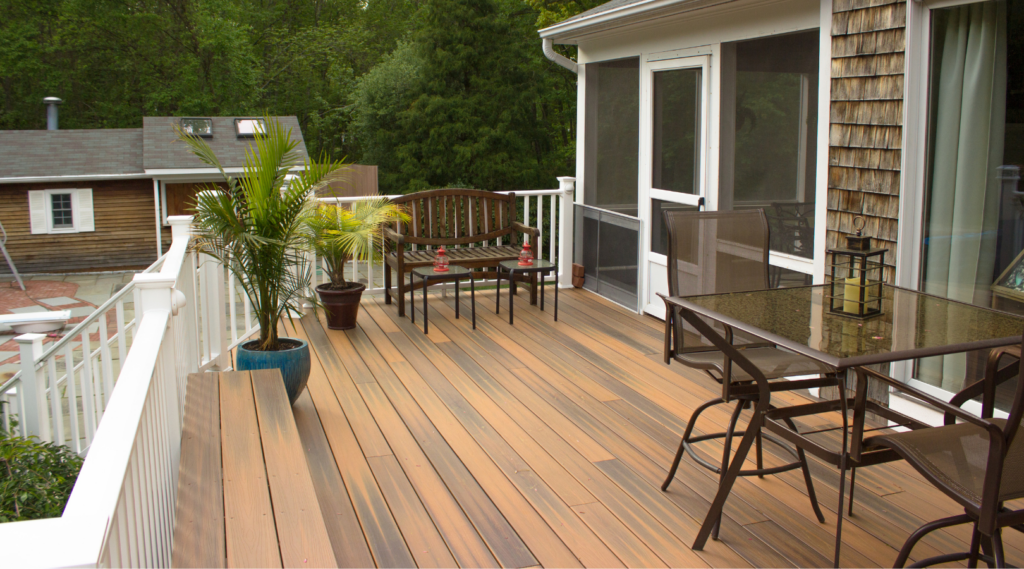When Should You Stain Your Dock for Your Minnesota Cabin?
Owning a cabin in Minnesota means more than just a place to relax; it’s about maintaining a legacy that gets passed down through generations. For many cabin owners, the dock is a centerpiece—where you fish, swim, and gather with family and friends. But like any other part of your cabin, the dock requires regular upkeep to stay in good shape. One of the most effective ways to preserve and protect it is by staining your dock.
But here’s the big question: When should you stain your dock for your Minnesota cabin? Timing is everything when it comes to preserving your dock’s beauty and functionality. With the harsh Minnesota winters and hot summers, you need to choose the right time to stain your dock for long-lasting results.
In this post, we’ll walk you through everything you need to know about staining your dock. From the best time to apply the stain to how to prepare the surface and choose the right products, we’ve got you covered. Let’s dive in!
Why Staining Your Dock Is Important for Minnesota Cabins
Staining your dock is more than just a cosmetic improvement; it’s a protective measure. For a Minnesota cabin, where the weather can be extreme, regular maintenance—especially staining—is essential to keep your dock in top shape. Here’s why you should make staining your dock a priority:
- Preserve the Wood’s Natural Beauty: Stain helps enhance the natural grain and color of the wood, giving your dock a fresh, clean look. Over time, without stain, your dock can fade and look weathered.
- Protect Against Minnesota’s Harsh Elements: Minnesota weather is notorious for its extremes. Freezing winters, scorching summers, and high humidity can all take a toll on your dock. Staining your dock creates a protective barrier that guards against UV damage, moisture, mildew, and freezing temperatures.
- Increase Longevity: A stained dock will last longer than an untreated one. Stain helps seal the wood, preventing it from absorbing too much water, which can lead to rot and warping.
- Prevent Slippery Surfaces: Some dock stains are designed with slip-resistant properties, which can help prevent accidents. This is especially important in a Minnesota cabin, where the dock can become slippery after rain, dew, or snow.

What Is the Ideal Time to Stain Your Dock in Minnesota?
Timing plays a crucial role when it comes to staining your dock. Staining at the wrong time can lead to poor adhesion, uneven drying, or ineffective protection. The best times to stain your dock in Minnesota are during the milder seasons of late spring or early fall. Here’s why:
Late Spring (May to June)
- Ideal Temperature: Late spring is one of the best times to stain your dock. The weather has warmed up but isn’t too hot yet. Temperatures between 50°F and 85°F are perfect for staining wood because the stain will dry properly and evenly.
- Dry Conditions: The late spring is usually dry enough, with fewer chances of rain compared to earlier in the season. Dry wood ensures that the stain will absorb correctly, creating a durable finish.
- Prepping for Summer: Staining your dock before summer means it’ll be ready for the heavy usage and sun exposure that comes with warm weather. Plus, you’ll avoid the rush of doing it in the hot, humid summer months.
Early Fall (September)
- Milder Temperatures: Early fall brings cooler temperatures and lower humidity, which are perfect for applying stain. The wood will dry evenly without the risk of it being too hot or too cold.
- Protecting from Winter: Staining in early fall gives your dock a protective coating before winter sets in. With Minnesota’s freezing winters, you want the wood sealed properly to prevent water from seeping into the dock and freezing, which could cause cracks and damage.
- Less Rain: Fall tends to be drier than spring, making it a great time to stain because you won’t have to worry as much about moisture messing with the application process.
Avoid Staining in Winter and Early Spring
- Winter: Staining your dock in the winter is a big no-no. Cold temperatures, snow, and ice will interfere with the curing process of most stains. Plus, it’s not ideal to work outdoors when temperatures are below freezing.
- Early Spring: Spring thawing means increased moisture in the air, which can make your dock too wet for staining. You want the wood to be dry before applying the stain, and early spring moisture can prevent that.
How to Prepare Your Dock for Staining
Preparing your dock properly is essential to ensure the stain adheres well and provides long-lasting protection. Here’s a step-by-step guide on how to prepare your dock for staining:
Clean the Surface
The first step in preparing your dock for staining is cleaning it thoroughly. If there’s dirt, algae, mildew, or grime on the surface, the stain won’t adhere properly. You can use a pressure washer for the best results, but be careful not to damage the wood with too much pressure. Alternatively, use a scrub brush and a wood cleaner to remove stubborn stains.
- Algae and Mildew Removal: Use a cleaner specifically designed to remove algae, mildew, or mold from wood.
- Debris: Remove leaves, twigs, and any other debris from the dock before you start cleaning.
Inspect for Damage
Before staining, inspect your dock for any damage, such as cracks, loose boards, or splinters. These need to be repaired before you apply the stain to ensure a smooth, even finish. If there are any areas that have significant damage, consider replacing the affected boards.
Dry the Wood Properly
For the stain to absorb properly, the wood needs to be dry. If there’s moisture on the dock, the stain will not adhere correctly, and the finish won’t be durable. After cleaning, give the dock time to dry completely before applying the stain. Depending on the weather, this could take anywhere from a few hours to a couple of days.
Sand If Necessary
If the wood is rough, splintered, or has peeling old stain, sand it down to ensure a smooth surface. Sanding also helps the new stain to adhere more effectively. Use a power sander for large areas and a hand sander for smaller sections.

Choosing the Right Stain for Your Minnesota Cabin Dock
The stain you choose plays a big role in the effectiveness of the protection it offers. In Minnesota’s climate, where weather extremes can be harsh, selecting the right stain is crucial.
Oil-Based vs. Water-Based Stains
- Oil-Based Stains: These penetrate deeply into the wood and provide long-lasting protection. They are excellent for docks that face direct sunlight and moisture. Oil-based stains also give wood a rich, natural appearance.
- Water-Based Stains: While easier to clean up and dry faster, water-based stains tend to sit more on the surface rather than penetrating the wood. This means they may need to be reapplied more frequently than oil-based stains.
UV Protection
Look for a stain that provides UV protection to prevent sun damage. UV rays can cause the wood to fade and deteriorate over time. A good UV-protective stain will maintain the color and integrity of your dock for a longer period.
Weather Resistance
Given Minnesota’s extreme weather conditions, you need a stain that resists moisture, mildew, and temperature changes. Choose a high-quality stain that’s formulated to protect against rain, snow, and humidity.
Step-by-Step Process for Staining Your Dock
Now that your dock is prepped and you’ve chosen the right stain, it’s time to get to work! Here’s a simple, step-by-step guide to staining your dock:
Step 1: Gather Your Supplies
Make sure you have everything you need before you begin:
- Stain (oil or water-based)
- Paint roller or brush (or sprayer if preferred)
- Pressure washer or scrub brush
- Sandpaper (if needed)
- Drop cloths or plastic sheeting
Step 2: Apply the First Coat
Using a roller, brush, or sprayer, apply a thin, even coat of stain to your dock. Start from one end and work your way down, ensuring you cover every part of the surface. Make sure not to overload the brush or roller, as this can lead to streaks.
Step 3: Apply a Second Coat
If the wood absorbs the first coat quickly and the surface looks patchy, you may need to apply a second coat. Be sure to let the first coat dry completely before applying the second one.
Step 4: Let It Dry
Allow the stain to dry for 24 to 48 hours, depending on weather conditions. Don’t walk on the dock or expose it to water during this time. After it has fully dried, your dock will be ready for use!
The Longevity of Your Dock Stain in Minnesota
The lifespan of your dock stain depends on several factors, including the type of stain used, the condition of the wood, and how often the dock is exposed to the elements. On average, you can expect your stain to last anywhere from 1 to 3 years in Minnesota’s climate. However, regular touch-ups will help maintain its appearance and protection.
Staining your dock for your Minnesota cabin is an investment that will pay off in the long run. Whether you choose to tackle the project yourself or hire a professional, the key to a beautiful, long-lasting dock is choosing the right time, products, and preparation. If you’re ready to ensure your dock is well-maintained and protected, That 1 Painter Northern Minneapolis is here to help! Our team of experts is ready to assist with your dock staining needs and provide the care your cabin